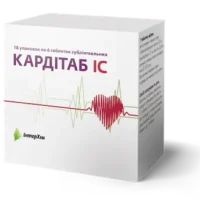Description
Lamotrin-100 Tablets 100 mg. №60
Ingredients:
Each tablet contains 100 mg of Lamotrigine.
Mechanism of Action:
Lamotrigine, the active ingredient in Lamotrin-100 tablets, stabilizes electrical activity in the brain, reducing the occurrence of seizures. It modulates voltage-gated sodium channels and inhibits the release of glutamate, a neurotransmitter involved in seizure generation.
Pharmacological Properties:
Lamotrigine is an antiepileptic drug that acts by blocking voltage-sensitive sodium channels, stabilizing neuronal membranes, and inhibiting glutamate release.
Indications for Use:
Lamotrin-100 tablets are indicated for the treatment of epilepsy in adults and children. They can be used alone or in combination with other antiepileptic medications.
Contraindications:
Do not use Lamotrin-100 tablets if you are allergic to Lamotrigine or any other ingredients in the formulation. Consult your healthcare provider before starting this medication to discuss any medical conditions or medications.
Side Effects:
Common side effects of Lamotrin-100 tablets may include dizziness, headache, nausea, and blurred vision. Serious side effects such as skin rash or mood changes should be reported to a healthcare provider immediately.
Usage Instructions:
Take Lamotrin-100 tablets orally as directed by your healthcare provider. The dosage is individualized and may start low, gradually increasing to achieve the desired therapeutic effect. Do not crush or chew the tablets.
Benefits Compared to Analogues:
Lamotrigine has shown a favorable side effect profile and good tolerability compared to other antiepileptic drugs. It has demonstrated effectiveness in seizure control and improving quality of life in individuals with epilepsy.
Suitable Patient Groups:
Lamotrin-100 tablets are suitable for both children and elderly patients with epilepsy. Dosage adjustments may be necessary based on age and individual health conditions.
Storage and Shelf Life:
Store Lamotrin-100 tablets in a cool, dry place away from direct sunlight. Check the expiration date on the packaging and do not use the tablets beyond that date.
Packaging Description:
Lamotrin-100 tablets are available in a package containing 60 tablets, each tablet being 100 mg. The packaging is designed to maintain the stability and integrity of the tablets.
Clinical Evidence and Proven Effectiveness:
Studies have shown that Lamotrigine effectively reduces seizure frequency in patients with epilepsy. Research published in the Journal of Neurology, Neurosurgery & Psychiatry has demonstrated its efficacy in both newly diagnosed and refractory epilepsy cases.





